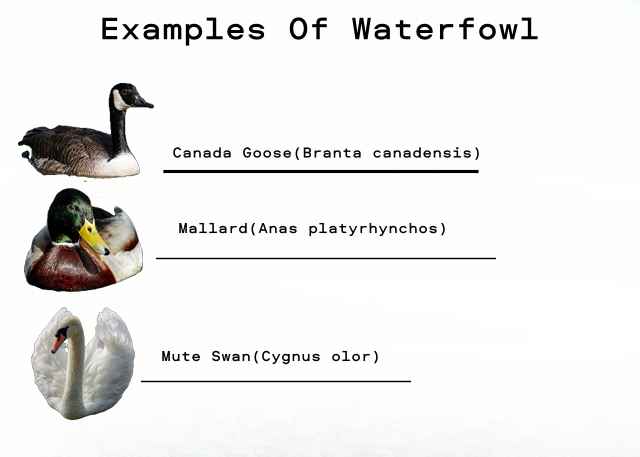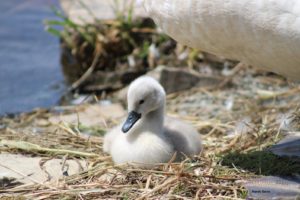
By: David Torres
A fowl is another word for bird, so a waterfowl is a bird that spends most of its life in and around water. the term Waterfowl is typically used for the birds that belong to the Anatidae family, the ducks, geese, and swans. However occasionally other birds such as loons, grebes, coots, and cormorants are considered waterfowl. This article will focus on the Anatidae family since ducks, geese, and swans are more typically considered waterfowl.
Waterfowl are found on every continent except Antarctica and are usually migratory birds, which means they like to fly south for the winter. That being said, large flocks of Mallards and Canada Geese remain in the mild Pacific Northwest climate throughout the year, where they can find food and shelter year-round.
All waterfowl have webbed feet and are mid-sized to large birds with plump bodies, long necks, and short wings. Swans are the largest type and can easily be spotted by their long necks, white feathers, and black beaks called bills.
Geese tend to be smaller than swans and have shorter bills; ducks are typically the smallest member of the Anatidae family, with much more variety in the colors of their feathers.
All members of the Anatidae family lay several eggs at a time. They hatch covered in down and are able to swim and eat on their own almost immediately after hatching.
Ducks
One of the most common waterfowl is the duck. There are all kinds of ducks that can be found around the world and the most well-known in the continent of North America is the Mallard.
They can be found from the tips of Alaska to northern Mexico and northern Florida. Their preferred habitats include ponds, lakes, marshes, bays, and city ponds.
The male Mallard has a gray body, green head, white neck ring, yellow bill, and orange legs and feet. Females are not as colorful with their brown feathers and orange-brown bills.
Mallards are considered dabbling ducks, which means they feed at the surface or tip their rear up to reach underwater. They take flight by springing up directly from the water, unlike diving ducks.
Diving ducks, such as Hooded Mergansers, find their food by diving and swimming underwater. Their feet are more designed for swimming than walking.
Depending on the species ducks eat a variety of food, including small fish and fish eggs, snails, worms, slugs, small crustaceans, insects, frogs, tadpoles, salamanders, grass, leaves, weeds, algae, aquatic plants and roots, seeds, and grain.
Geese
There are around 30 species of geese in the world which they typically live in low marshes, river valleys, and wet pastures – depending on the season.
Geese are mostly herbivores and eat grasses and other plant materials, such as roots, leaves, and sprouts. A common diet for farm-raised geese are wheat and pellets. Geese may also eat insects, rice, and corn.
They range in size but are usually larger than a duck and smaller than a swan. A goose is often characterized by its long neck, webbed feet, and honk.
Geese were one of the first animals to be domesticated. Their domestication probably took place in Egypt about 3 000 years ago.
Domesticated geese are often raised on farms. They forage on grassy pasture for food, and are given yards, sometimes with sheds as shelter.
On average, they live to be 10 to 20 years old in the wild and can live up to 20 to 25 years in captivity. However, a few individual geese have been known to live for much longer.
Migratory geese fly in a V-shaped formation to minimize wind resistance and help save energy for the trip. Geese honk while in flight to enable communication and encourage the flock to maintain a “V” formation.
Geese are very loyal. If a goose’s mate or chicks become sick or injured, they will often refuse to leave them – even if winter is approaching and the other geese in the group are flying south.
The term for a female goose is usually just goose, whereas a male is known as a gander and baby geese are known as goslings.
During nesting season, geese typically travel in pairs. Geese lay up to 12 eggs and goslings can fly when they are about 2-3 months old. They will stay with their parents and, the following year, return with them to the place where they were born. There they will form flocks with other young geese.
Swans
Swans are the largest members of the Anatidae family. They are known for their beautiful white feathers, long curved neck, and they usually have a black bill.
There are Black Swans in Australia with red bills and Mute Swans that can be identified by their orange bill. Altogether, there are only about six or seven kinds of swans, making them the less diverse birds in the Anatidae family.
Most swans are found in the northern hemisphere, with a few species being found south of the equator in Australia and South America. Southern swans tend to be a mixture of white and black in color, with red, orange, or black beaks.
Swans primarily feed on aquatic vegetation; their long necks allow them to feed on plants growing on riverbeds and they also eat small creatures that cling to the vegetation. Swans will also graze in fields, eating grass if it is available.

A male swan is called a cob, a female swan is called a pen, and a baby swan is called a cygnet. When a pen is ready to lay eggs, she makes a nest out of twigs and leaves; this process can take up to 2-3 weeks. She then sits on them for 6 weeks or longer until they hatch. Swans will hatch up to 10 eggs at once and the cygnets stay with their mother for the first 6 months of their life. After that it will go off on its own to start a new family.
